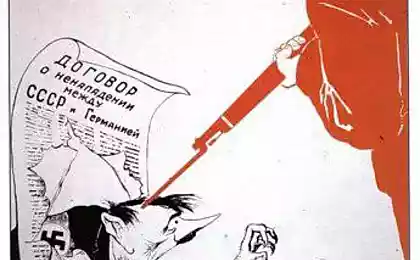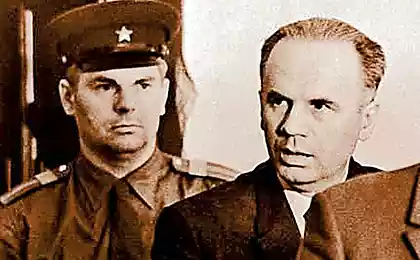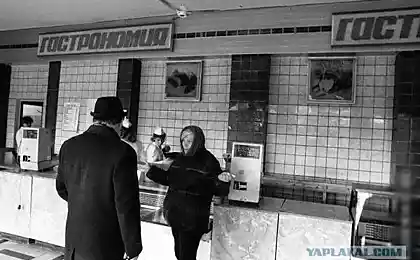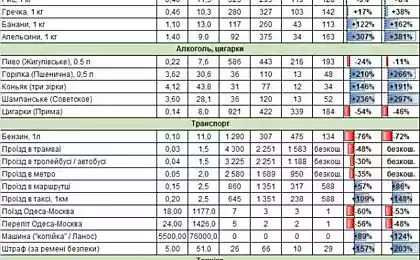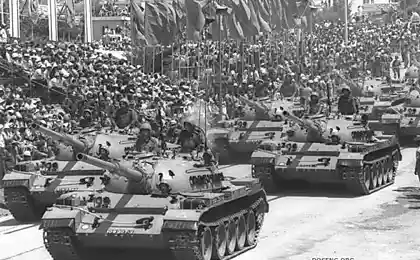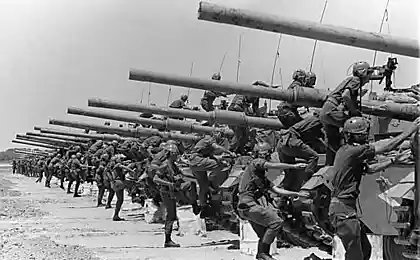1427
Five of the most successful Soviet assault landings
January 5, 1942 in Yevpatoriya Yevpatoriya troops landed, which contributed to the consolidation of the success of Soviet troops in the Kerch Peninsula. Of the 700 Marines survived less than a hundred. Their feat Vladimir Vysotsky dedicated the song "Black jackets". We decided to recall the five most successful Soviet assault landings.
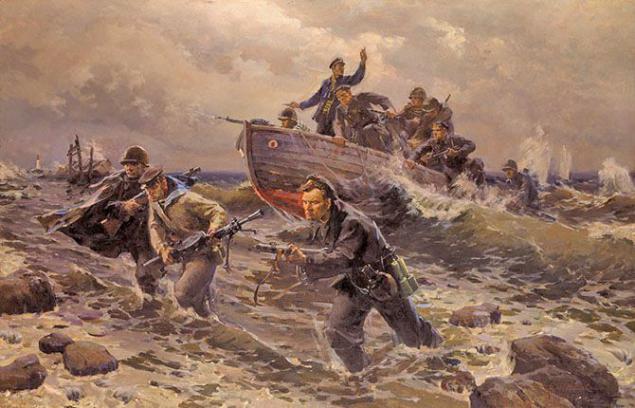
Yevpatoriya LANDING
The main striking force of Yevpatoria landing consisted of a battalion of marines: 553 infantry under the command of Lieutenant-Commander G. Buzinova 60 scouts and fleet headquarters. Only at sea paratroopers say where they are sent and for what purpose. During landing suffered first casualties - wounded and killed more than fifty people. In December the Germans had mined the coast and shone his spotlight. Seeing the ships they deliberately opened artillery and mortar fire. Despite the losses and the fact that the Germans, having received aid, has had more than five-fold superiority in manpower and overwhelming superiority in technology, paratroopers managed to seize the southern part of Yevpatoria. The battalion was able to gain a foothold in the old town, the number of men increased by the release of prisoners of war and Yevpatoriya. The bulk of the assault, a reinforced battalion under the command of the regiment commander Major N. Taran, had to come to the aid of the following morning, after the first wave of our troops. In case of success of all German troops in western Crimea would be a significant threat looms. However, the weather prevented: broke 8-point storm. Under these conditions, landing and unloading of heavy weapons is not possible. When from Sevastopol to Yalta left side of the two-speed torpedo boats with the necessary ammunition to soldiers, German fighters opened fire on them. As a result of the battle one boat sank, and the second - has returned to Sevastopol, he was again sent to Yevpatoria, but ran aground. Mariners desperately short of ammunition, but the city was able to hold for another three days. Of the 700 people survived only 40. In spite of the tragic finale, landing managed to divert part of the enemy forces from Sevastopol.
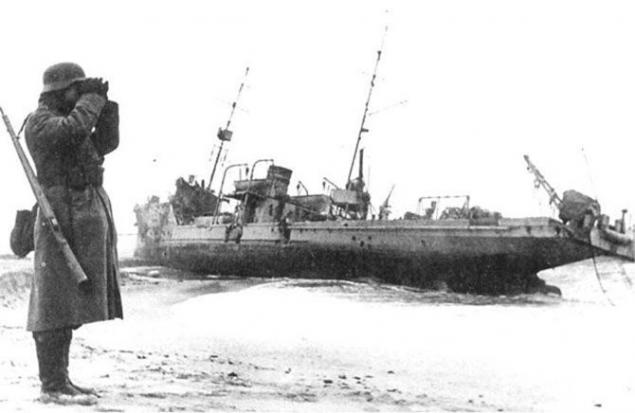
Minesweeper T-405, "Fuse", shot by the German field artillery during the landing of Yevpatoria landing in January 1942
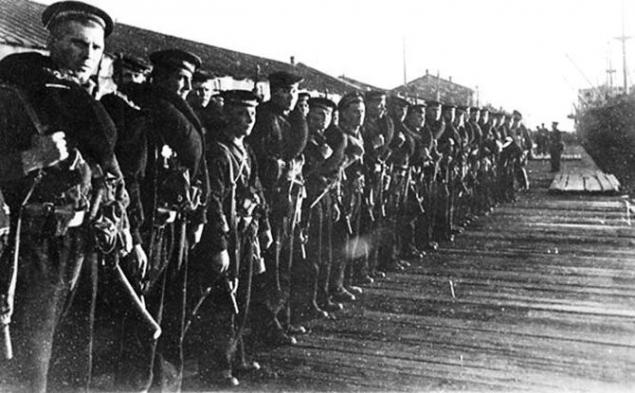
Grigoryevskaya LANDING
The first effective sea landing of our troops in the history of the Great Patriotic War became Grigorievsky troops - tactical marines, planted the Black Sea Fleet on the night of September 22, 1941 at the Black Sea coast near the village of Odessa region Grigorievka counterattack to support the defenders of Soviet troops near Odessa. By the end of the summer of 1941 in the Odessa region has developed a very difficult situation: the German-Romanian forces have significantly oust our part and approaching the city on 10-12 km, take the port of Odessa and the input channel is, is just 4-5 miles from the coast. Odessa risked to be besieged. The only way out of this situation was to conduct counter-offensives. Grigorievsky troops included three Marine battalions and mortar batteries total number of 1920 people. At the rear of the enemy paratroopers threw their sailors were recruited from volunteer air units of the fleet. Start of operation was a success: in a few hours paratroopers killed five lines wired communications, command post of the Romanian Infantry Regiment, knocked out 30 enemy soldiers and officers, and to the dawn of September 22 connected with the advancing units. Overall, as a result of this counter-attack Soviet troops drove the enemy at 8-10 km, it was crushed two Romanian infantry divisions. Our troops seized 19 guns of various calibers, 40 mortars, more than 1,200 rifles and machine guns, a large number of other military equipment. The enemy lost up to 2 thousand. Man and lost important bridgehead allows you to aim fire to the city and to keep under fire the port of Odessa. This experience is not just used in the future during amphibious operations.
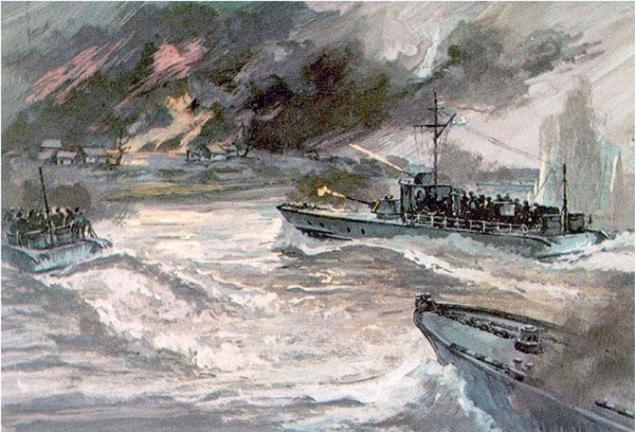
Danube LANDING
The Danube became the first Soviet troops landing during the Great Patriotic War, his training began on the second night of the war. As a result of the offensive, Soviet troops occupied the Cape Satul Nou, the city Kealia Veche, Pardini village and a number of settlements, and the islands of the Tatars, Separate and Dallaire. The advanced part of the landing was able to drive a wedge deep into enemy territory, and by the end of the operation reached a base width of 70 kilometers. Were destroyed by artillery reinforced infantry battalion and frontier, the enemy lost more than 200 soldiers and officers were killed, about 500 (according to other sources - 720) people surrendered, seized eight guns, 30 machine guns, more than a thousand rifles. Troopers also lost five men killed and seven wounded. Thus, on the fifth day of the war our ships was possible to relatively freely maneuver between Ishmael and the mouth of Chilia arm more actively support the ground forces. Again acting Izmail port. In addition, the Danube troops had not only purely tactical value. An important role in the general plight of the Soviet-German front at the beginning of the war played and moral significance of this successful operation: very important was the fact of the entry of Soviet troops into enemy territory. It is worth noting that out of all of Germany's allies Romanian army was the most numerous, well-armed and combat-ready. Supreme Commander of the composition had a real battle experience even during the First World. In addition, the saturation of the Romanian infantry machine guns at the start of the war was significantly higher than in the Wehrmacht.
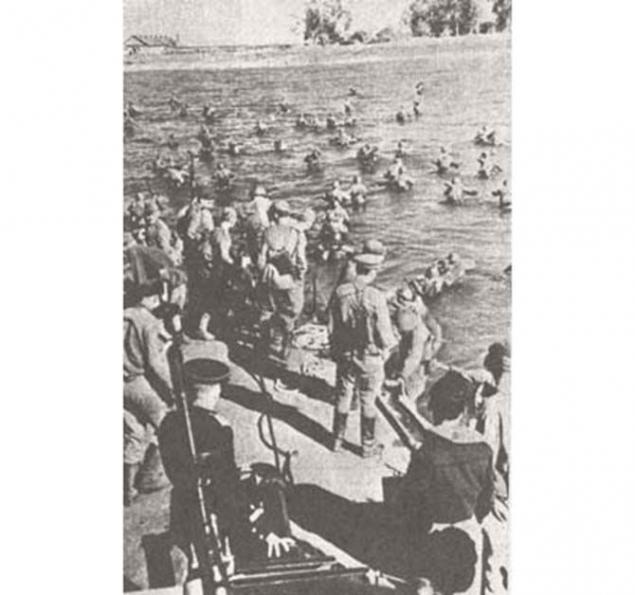
Landing on the warm lake
Tactical landing operation of the Soviet brigade of warships in the Tartu offensive of World War II was held on 16-17 August 1944. The operation began on the night of August 16, 1944. To eliminate the threat posed by enemy ships of the Baltic Fleet command has allocated 9 th assault aviation division (154 fighter and attack aircraft), as well as part of the 11 th assault aviation division of the fleet. Interestingly, the troops passed historic site Battle on the Ice in 1242. The landing was made in three echelons. German units on the banks were unable to stop the offensive, while the German command decided to use aircraft: German planes loaded continuous strikes on Soviet ships and staging points and landing ships on the east coast. Despite the superiority of forces in the landing area, the Soviet Air Force was not able to provide air cover. As a result, two days were sunk armored boat, landing three tender boats, two mine and two boats, minesweepers, 14 ferries sank seven of the 21 amphibious tenders remained in the ranks of six. The personnel of the airborne units also suffered significant damage. Nevertheless, in spite of the loss of ships through the Warm Lake were transferred part of both infantry divisions involved. Total time for this flotilla ships ferried across the lake about 7 thousand. Soldiers, 170 guns and mortars, more than 300 tons of ammunition and other cargo. 159th separate motorized pontoon bridge battalion further ferried more than 1,000 soldiers, 34 tons of cargo and 65 guns and mortars. The operation was crowned with absolute success, playing a major role in breaking the troops of the Soviet army in Tartu.
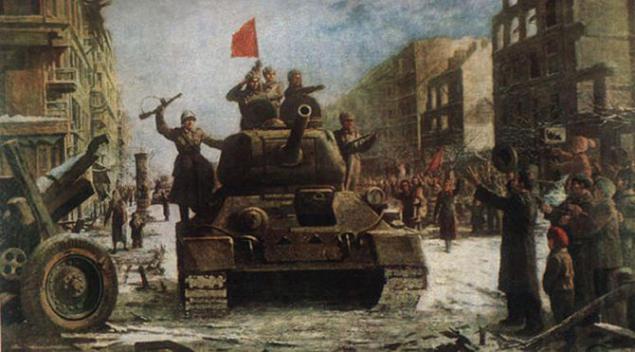
GERENSKY LANDING
Troopers Danube Flotilla in Budapest offensive of World War II, the purpose of which is to capture the stronghold of the enemy on the flank of the riverine his defense, creating a threat to the home front, the subsequent crossing of the bridgehead on the shooting case in order to accelerate the pace of advance. The operation was successful: December 1, 1944 the city Geren four hundred marines landed with 10 armored, was captured a bridgehead on the right bank of the Danube. There were transported 31 th Infantry Corps, 83rd Marine Brigade and other parts of the 4th Guards Army 3rd Ukrainian Front. The landing was a complete surprise to the enemy. The three-hour night battle troops knocked the opponent out of Gerena. In this battle, Marines killed 200 enemy soldiers and officers, 120 captured. Enemy troops were forced to retreat to start.
--img7--
Source:

Yevpatoriya LANDING
The main striking force of Yevpatoria landing consisted of a battalion of marines: 553 infantry under the command of Lieutenant-Commander G. Buzinova 60 scouts and fleet headquarters. Only at sea paratroopers say where they are sent and for what purpose. During landing suffered first casualties - wounded and killed more than fifty people. In December the Germans had mined the coast and shone his spotlight. Seeing the ships they deliberately opened artillery and mortar fire. Despite the losses and the fact that the Germans, having received aid, has had more than five-fold superiority in manpower and overwhelming superiority in technology, paratroopers managed to seize the southern part of Yevpatoria. The battalion was able to gain a foothold in the old town, the number of men increased by the release of prisoners of war and Yevpatoriya. The bulk of the assault, a reinforced battalion under the command of the regiment commander Major N. Taran, had to come to the aid of the following morning, after the first wave of our troops. In case of success of all German troops in western Crimea would be a significant threat looms. However, the weather prevented: broke 8-point storm. Under these conditions, landing and unloading of heavy weapons is not possible. When from Sevastopol to Yalta left side of the two-speed torpedo boats with the necessary ammunition to soldiers, German fighters opened fire on them. As a result of the battle one boat sank, and the second - has returned to Sevastopol, he was again sent to Yevpatoria, but ran aground. Mariners desperately short of ammunition, but the city was able to hold for another three days. Of the 700 people survived only 40. In spite of the tragic finale, landing managed to divert part of the enemy forces from Sevastopol.

Minesweeper T-405, "Fuse", shot by the German field artillery during the landing of Yevpatoria landing in January 1942

Grigoryevskaya LANDING
The first effective sea landing of our troops in the history of the Great Patriotic War became Grigorievsky troops - tactical marines, planted the Black Sea Fleet on the night of September 22, 1941 at the Black Sea coast near the village of Odessa region Grigorievka counterattack to support the defenders of Soviet troops near Odessa. By the end of the summer of 1941 in the Odessa region has developed a very difficult situation: the German-Romanian forces have significantly oust our part and approaching the city on 10-12 km, take the port of Odessa and the input channel is, is just 4-5 miles from the coast. Odessa risked to be besieged. The only way out of this situation was to conduct counter-offensives. Grigorievsky troops included three Marine battalions and mortar batteries total number of 1920 people. At the rear of the enemy paratroopers threw their sailors were recruited from volunteer air units of the fleet. Start of operation was a success: in a few hours paratroopers killed five lines wired communications, command post of the Romanian Infantry Regiment, knocked out 30 enemy soldiers and officers, and to the dawn of September 22 connected with the advancing units. Overall, as a result of this counter-attack Soviet troops drove the enemy at 8-10 km, it was crushed two Romanian infantry divisions. Our troops seized 19 guns of various calibers, 40 mortars, more than 1,200 rifles and machine guns, a large number of other military equipment. The enemy lost up to 2 thousand. Man and lost important bridgehead allows you to aim fire to the city and to keep under fire the port of Odessa. This experience is not just used in the future during amphibious operations.

Danube LANDING
The Danube became the first Soviet troops landing during the Great Patriotic War, his training began on the second night of the war. As a result of the offensive, Soviet troops occupied the Cape Satul Nou, the city Kealia Veche, Pardini village and a number of settlements, and the islands of the Tatars, Separate and Dallaire. The advanced part of the landing was able to drive a wedge deep into enemy territory, and by the end of the operation reached a base width of 70 kilometers. Were destroyed by artillery reinforced infantry battalion and frontier, the enemy lost more than 200 soldiers and officers were killed, about 500 (according to other sources - 720) people surrendered, seized eight guns, 30 machine guns, more than a thousand rifles. Troopers also lost five men killed and seven wounded. Thus, on the fifth day of the war our ships was possible to relatively freely maneuver between Ishmael and the mouth of Chilia arm more actively support the ground forces. Again acting Izmail port. In addition, the Danube troops had not only purely tactical value. An important role in the general plight of the Soviet-German front at the beginning of the war played and moral significance of this successful operation: very important was the fact of the entry of Soviet troops into enemy territory. It is worth noting that out of all of Germany's allies Romanian army was the most numerous, well-armed and combat-ready. Supreme Commander of the composition had a real battle experience even during the First World. In addition, the saturation of the Romanian infantry machine guns at the start of the war was significantly higher than in the Wehrmacht.

Landing on the warm lake
Tactical landing operation of the Soviet brigade of warships in the Tartu offensive of World War II was held on 16-17 August 1944. The operation began on the night of August 16, 1944. To eliminate the threat posed by enemy ships of the Baltic Fleet command has allocated 9 th assault aviation division (154 fighter and attack aircraft), as well as part of the 11 th assault aviation division of the fleet. Interestingly, the troops passed historic site Battle on the Ice in 1242. The landing was made in three echelons. German units on the banks were unable to stop the offensive, while the German command decided to use aircraft: German planes loaded continuous strikes on Soviet ships and staging points and landing ships on the east coast. Despite the superiority of forces in the landing area, the Soviet Air Force was not able to provide air cover. As a result, two days were sunk armored boat, landing three tender boats, two mine and two boats, minesweepers, 14 ferries sank seven of the 21 amphibious tenders remained in the ranks of six. The personnel of the airborne units also suffered significant damage. Nevertheless, in spite of the loss of ships through the Warm Lake were transferred part of both infantry divisions involved. Total time for this flotilla ships ferried across the lake about 7 thousand. Soldiers, 170 guns and mortars, more than 300 tons of ammunition and other cargo. 159th separate motorized pontoon bridge battalion further ferried more than 1,000 soldiers, 34 tons of cargo and 65 guns and mortars. The operation was crowned with absolute success, playing a major role in breaking the troops of the Soviet army in Tartu.

GERENSKY LANDING
Troopers Danube Flotilla in Budapest offensive of World War II, the purpose of which is to capture the stronghold of the enemy on the flank of the riverine his defense, creating a threat to the home front, the subsequent crossing of the bridgehead on the shooting case in order to accelerate the pace of advance. The operation was successful: December 1, 1944 the city Geren four hundred marines landed with 10 armored, was captured a bridgehead on the right bank of the Danube. There were transported 31 th Infantry Corps, 83rd Marine Brigade and other parts of the 4th Guards Army 3rd Ukrainian Front. The landing was a complete surprise to the enemy. The three-hour night battle troops knocked the opponent out of Gerena. In this battle, Marines killed 200 enemy soldiers and officers, 120 captured. Enemy troops were forced to retreat to start.
--img7--
Source:










